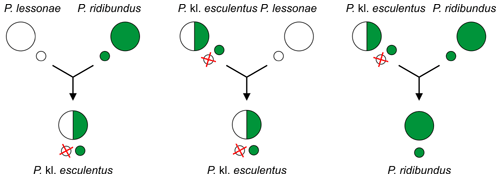 Global Information
Global InformationHybridogenesis in water frogs information

The fertile hybrids of European water frogs (genus Pelophylax) reproduce by hybridogenesis (hemiclonally). This means that during gametogenesis, they discard the genome of one of the parental species and produce gametes of the other parental species (containing a genome not recombined with the genome of the first parental species).[1][2][3][4] The first parental genome is restored by fertilization of these gametes with gametes from the first species (sexual host).[5][1][4] In all-hybrid populations of the edible frog Pelophylax kl. esculentus, however, triploid hybrids provide this missing genome.[3][6][2]
Because half of the genome is transmitted to the next generation clonally (not excluded unrecombined intact genome), and only the other half sexually (recombined genome of the sexual host), the hybridogenesis is a hemiclonal mode of reproduction.[7][8][4]
For example, the edible frog Pelophylax kl. esculentus (mostly RL genome), which is a hybridogenetic hybrid of the marsh frog P. ridibundus (RR) and the pool frog P. lessonae (LL), usually excludes the lessonae genome (L) and generates gametes of the P. ridibundus (R). In other words, edible frogs produce gametes of marsh frogs.[2][3][4]
The hybrid populations are propagated, however, not by the above primary hybridisations, but predominantly by backcrosses with one of the parental species they coexist (live in sympatry[9][10]) with (see below in the middle). [11][2][3][12][9][4]

Since the hybridogenetic hybrids require another taxon as sexual host to reproduce, usually one of the parental species, they are called kleptons[13][14][5] (with "kl." in scientific names[15]).

There are three known hybridogenetic hybrids of the European water frogs:
- edible frog Pelophylax kl. esculentus (usually genotype RL):
pool frog P. lessonae (LL) × P. ridibundus (RR)[11][2] - Graf's hybrid frog Pelophylax kl. grafi (PR):
Perez's frog P. perezi (PP) × P. ridibundus (RR) or
Perez's frog P. perezi (PP) × edible frog P. kl. esculentus (RE)
(it is unclear which one crossing was the primary hybridisation)[2] - Italian edible frog Pelophylax kl. hispanicus (RB):
Italian pool frog P. bergeri (BB) × P. ridibundus (RR)[2]
- ^ a b Cite error: The named reference
Vrijenhoek98was invoked but never defined (see the help page). - ^ a b c d e f g h i j k Cite error: The named reference
Holsbeek10was invoked but never defined (see the help page). - ^ a b c d e f Cite error: The named reference
Christiansen09was invoked but never defined (see the help page). - ^ a b c d e f g Cite error: The named reference
Ragghianti07was invoked but never defined (see the help page). - ^ a b Cite error: The named reference
PollsPelaz90was invoked but never defined (see the help page). - ^ Cite error: The named reference
Pruvost13was invoked but never defined (see the help page). - ^ Cite error: The named reference
Simon03was invoked but never defined (see the help page). - ^ a b c Cite error: The named reference
Vorburger03was invoked but never defined (see the help page). - ^ a b c Cite error: The named reference
SpolskyUzzell86was invoked but never defined (see the help page). - ^ Cite error: The named reference
Christiansen09_2was invoked but never defined (see the help page). - ^ a b c Cite error: The named reference
Berger70was invoked but never defined (see the help page). - ^ a b Cite error: The named reference
TietjeReyer04was invoked but never defined (see the help page). - ^ Cite error: The named reference
Dubois09was invoked but never defined (see the help page). - ^ Cite error: The named reference
Dubois82was invoked but never defined (see the help page). - ^ Cite error: The named reference
Dubois90was invoked but never defined (see the help page).